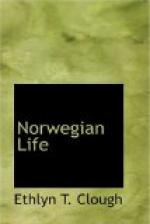No more conscientious, hardworking, and respectable class of men and women can be found than the teachers. Eight years’ study, first in a special seminary and then in a training college, has taught them their profession both in theory and practice. They are convinced of the importance and dignity of their office, and are respected accordingly. Socially, the general type of the school teacher is a superior one. There are at present in the Riksdag, occupying seats as members of the second chamber, no fewer than eleven teachers in elementary schools, twelve teachers in secondary schools, one inspector of schools, and one university professor. In the rural community, the school teacher is something of an authority. Most of the members of the parish have “sat under him” at school in their early life, and owe to him most of what they know. For years he has been diffusing knowledge around him, and has been looked up to as the fountain of book learning. He is the local parson’s great coadjutor in parish matters, and being a ready speaker, is of no mean influence in the parish assemblies. The one dark blot in the existence of the school teacher is the small salary received. Few of them receive so much as $300 a year, the average running from $225 to $275; even in Stockholm the figure going little beyond $300. Living is, however, cheap in the rural districts, and these teachers, who are drawn generally from the rural and indigent classes, are accustomed to frugality and economy. They are lodged free of rent in the schoolhouse or a cottage attached to it, and are allowed firewood and other small prerequisites. They have generally a small garden or potato patch to cultivate, and can keep a cow and a few hens. They often add to their modest stipend by extra work, such as teaching in the evening classes, playing the organ in church, and writing, or some such work after school hours.
At fifteen, after seven years’ assiduous attendance at the Folkskola, the boy and girl have finished their education, so far as compulsory instruction goes, and they are free to begin work on their father’s farm, in his shop or his trade, or take service anywhere and shift for themselves. They may, however, if they like, pursue their studies further in the continuation schools, or in the evening classes provided in most parishes, or repair to a college or gymnasium town, if they elect to enter the church, the liberal professions, or the service of the state. But they have first to be confirmed, and it is here that the definite religious instruction is given. The preparation for confirmation, which entails a much longer and more advanced course of religious instruction than is usual for confirmation in England, is independent of the school and takes place in church, parents being allowed every liberty in the choice of the clergyman who performs this office for their children. English readers who are acquainted with Longfellow’s admirable translation of Tegner’s beautiful poem,




